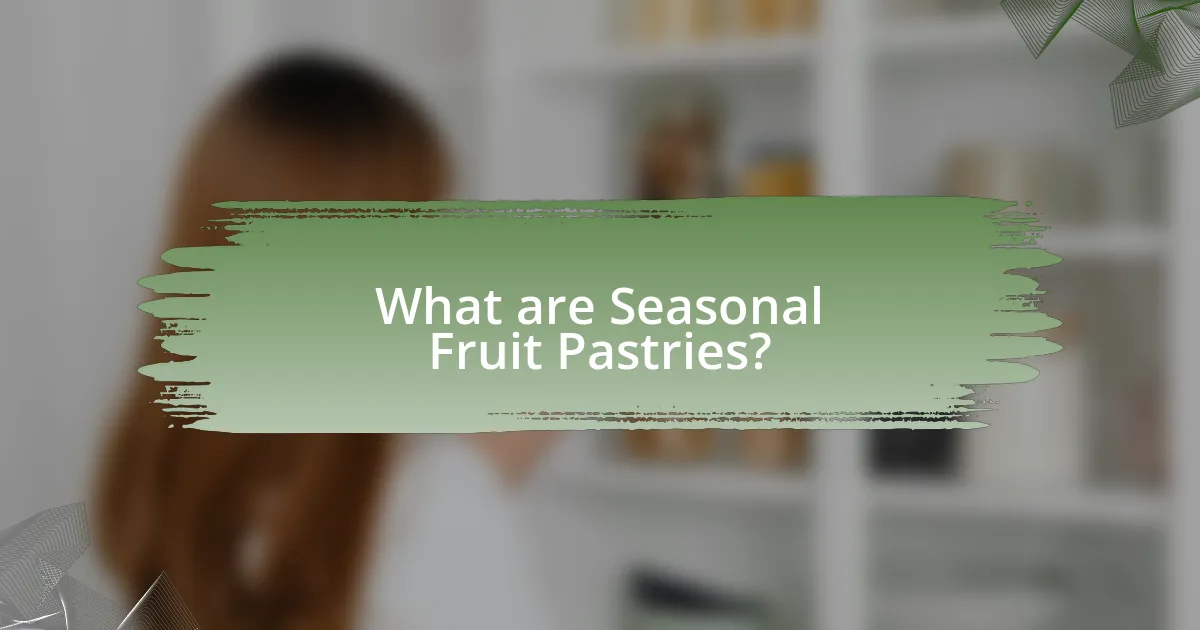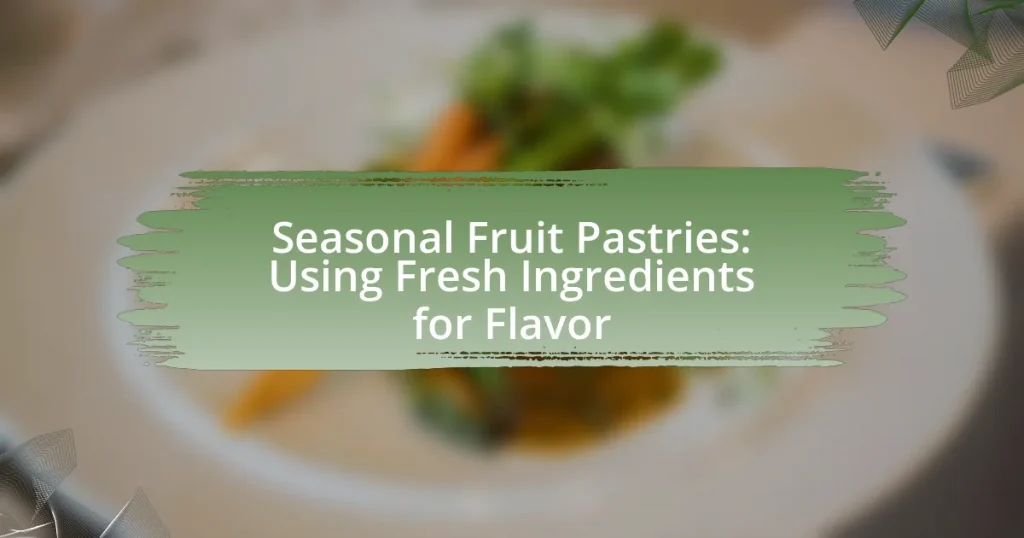Seasonal fruit pastries are baked goods that prominently feature fresh, seasonal fruits, enhancing their flavor and appeal. These pastries typically consist of a flaky or buttery crust filled with fruits at their peak ripeness, such as berries in summer or apples in autumn. The article explores the definition, ingredients, and health benefits of seasonal fruit pastries, as well as their cultural significance and popularity during seasonal celebrations. It also provides guidance on making these pastries at home, including tips for selecting the best fruits, customizing recipes for dietary needs, and avoiding common baking mistakes. Additionally, the article highlights creative flavor combinations and variations, emphasizing the importance of using fresh, local ingredients for optimal taste and nutritional value.

What are Seasonal Fruit Pastries?
Seasonal fruit pastries are baked goods that incorporate fresh, seasonal fruits as a primary ingredient, enhancing their flavor and appeal. These pastries often feature a flaky or buttery crust filled with fruits that are at their peak ripeness, such as berries in summer or apples in autumn. The use of seasonal fruits not only elevates the taste but also aligns with the practice of utilizing ingredients that are locally available and fresh, which can improve nutritional value and support local agriculture.
How are Seasonal Fruit Pastries defined?
Seasonal fruit pastries are defined as baked goods that incorporate fresh, seasonal fruits as a primary ingredient, enhancing their flavor and appeal. These pastries typically feature a flaky or tender crust filled with fruits that are at their peak ripeness, which not only contributes to the taste but also reflects the time of year they are made. For example, summer might see the use of berries, while autumn could feature apples or pears. The emphasis on using fresh, seasonal ingredients ensures that the pastries are flavorful and vibrant, aligning with culinary practices that prioritize local and seasonal produce.
What ingredients are typically used in Seasonal Fruit Pastries?
Seasonal fruit pastries typically use ingredients such as fresh seasonal fruits, pastry dough, sugar, butter, and sometimes spices like cinnamon or nutmeg. Fresh seasonal fruits, such as berries, apples, or peaches, provide the primary flavor and texture, while pastry dough serves as the base. Sugar enhances sweetness, and butter contributes to the richness and flakiness of the pastry. Spices may be added to complement the fruit flavors, creating a balanced and flavorful dessert.
How do seasonal fruits influence the flavor profile of these pastries?
Seasonal fruits significantly enhance the flavor profile of pastries by introducing fresh, vibrant tastes that reflect their peak ripeness. For instance, summer berries like strawberries and blueberries add sweetness and acidity, while autumn fruits such as apples and pears contribute warmth and spice. The natural sugars in these fruits caramelize during baking, intensifying their flavors and creating a complex taste experience. Additionally, the unique characteristics of each fruit, such as the tartness of citrus or the richness of stone fruits, allow for diverse flavor combinations that elevate the overall pastry. This seasonal approach not only improves taste but also aligns with culinary trends favoring fresh, local ingredients, making pastries more appealing to consumers.
Why are Seasonal Fruit Pastries popular?
Seasonal fruit pastries are popular due to their use of fresh, high-quality ingredients that reflect the flavors of specific seasons. The incorporation of seasonal fruits enhances taste and texture, making these pastries more appealing to consumers. For example, fruits like strawberries in spring or apples in autumn not only provide vibrant flavors but also align with seasonal harvests, ensuring optimal freshness. This connection to seasonal availability often leads to increased consumer interest and demand, as people seek to enjoy the best flavors at their peak.
What cultural significance do Seasonal Fruit Pastries hold?
Seasonal fruit pastries hold significant cultural importance as they often symbolize the celebration of harvest and seasonal changes in various cultures. These pastries are traditionally made using fresh, locally sourced fruits, reflecting the agricultural practices and seasonal availability of ingredients in a region. For instance, in many European countries, fruit tarts and pies are integral to seasonal festivals, marking the transition from one season to another, such as apple pies in autumn or berry tarts in summer. This connection to local produce not only promotes community engagement but also preserves culinary heritage, as recipes are passed down through generations, reinforcing cultural identity and continuity.
How do Seasonal Fruit Pastries fit into seasonal celebrations and events?
Seasonal fruit pastries are integral to seasonal celebrations and events as they highlight the availability of fresh, local ingredients during specific times of the year. These pastries often feature fruits that are in season, such as strawberries in spring or apples in autumn, which enhances their flavor and nutritional value. For example, during harvest festivals, apple pies or tarts made with freshly picked apples symbolize the bounty of the season and are often shared among families and communities. Additionally, seasonal fruit pastries are commonly served at holidays like Thanksgiving and Christmas, where they serve as traditional desserts that evoke nostalgia and cultural significance. This connection to seasonal ingredients not only elevates the culinary experience but also fosters a sense of community and celebration around the changing seasons.
What are the health benefits of using fresh ingredients in Seasonal Fruit Pastries?
Using fresh ingredients in seasonal fruit pastries provides numerous health benefits, including higher nutrient content and reduced levels of preservatives. Fresh fruits are rich in vitamins, minerals, and antioxidants, which support overall health and boost the immune system. For example, fruits like berries and citrus are high in vitamin C, which is essential for collagen production and immune function. Additionally, fresh ingredients often contain fewer added sugars and unhealthy fats compared to processed alternatives, contributing to better heart health and weight management. Studies have shown that diets rich in fruits and vegetables can lower the risk of chronic diseases such as heart disease and diabetes, reinforcing the health advantages of incorporating fresh ingredients into pastries.
How do fresh fruits contribute to nutritional value?
Fresh fruits significantly enhance nutritional value by providing essential vitamins, minerals, and dietary fiber. For instance, fruits like oranges and strawberries are rich in vitamin C, which supports immune function, while bananas offer potassium, crucial for heart health. Additionally, the fiber found in fruits aids digestion and helps maintain a healthy weight by promoting satiety. Research indicates that diets high in fruits can reduce the risk of chronic diseases, such as heart disease and diabetes, due to their antioxidant properties and low-calorie content.
What are the advantages of using organic ingredients in baking?
Using organic ingredients in baking offers several advantages, including enhanced flavor, improved nutritional value, and reduced exposure to harmful chemicals. Organic ingredients are grown without synthetic pesticides and fertilizers, which can lead to a more robust and natural taste in baked goods. Studies indicate that organic produce often contains higher levels of antioxidants and essential nutrients, contributing to better overall health. Additionally, using organic ingredients supports sustainable farming practices, promoting environmental health and biodiversity.

How can you make Seasonal Fruit Pastries at home?
To make Seasonal Fruit Pastries at home, start by preparing a pastry dough using flour, butter, sugar, and water, mixing until it forms a smooth consistency. Roll out the dough and cut it into desired shapes, then place them on a baking sheet. Next, prepare a filling by combining seasonal fruits such as berries, apples, or peaches with sugar and a bit of cornstarch to thicken. Spoon the fruit mixture onto the center of each pastry shape, fold or crimp the edges to seal, and brush with an egg wash for a golden finish. Bake in a preheated oven at 375°F (190°C) for 20-25 minutes until golden brown. This method utilizes fresh ingredients, enhancing the flavor and texture of the pastries.
What are the essential steps in preparing Seasonal Fruit Pastries?
The essential steps in preparing Seasonal Fruit Pastries include selecting fresh seasonal fruits, preparing the pastry dough, assembling the pastries, and baking them. First, choose ripe fruits that are in season, such as berries in summer or apples in fall, as they provide optimal flavor. Next, prepare the pastry dough, which can be made from scratch or purchased pre-made, ensuring it is chilled for easier handling. After that, assemble the pastries by rolling out the dough, placing the fruit mixture inside, and sealing the edges. Finally, bake the pastries in a preheated oven until golden brown, typically at 375°F for 20-25 minutes, allowing the flavors to meld and the pastry to achieve a flaky texture.
How do you select the best seasonal fruits for your pastries?
To select the best seasonal fruits for pastries, prioritize fruits that are at their peak ripeness and flavor during the specific season. Seasonal fruits, such as strawberries in spring or apples in fall, offer optimal sweetness and texture, enhancing the overall quality of pastries. Research indicates that fruits harvested at their peak contain higher levels of vitamins and antioxidants, which contribute to both flavor and health benefits. For example, strawberries are known to have a higher sugar content and better taste when picked in late spring, making them ideal for desserts during that time.
What techniques can enhance the flavor of Seasonal Fruit Pastries?
To enhance the flavor of seasonal fruit pastries, techniques such as using fresh, ripe fruits, incorporating complementary spices, and applying glazes or syrups can be effective. Fresh, ripe fruits provide natural sweetness and acidity, which elevate the overall taste profile. Complementary spices like cinnamon or nutmeg can add warmth and depth, enhancing the fruit’s inherent flavors. Additionally, applying a glaze made from fruit juices or syrups can create a shiny finish and intensify the fruit’s flavor, making the pastry more appealing. These methods are supported by culinary practices that emphasize the importance of ingredient quality and flavor pairing in pastry making.
What common mistakes should be avoided when making Seasonal Fruit Pastries?
Common mistakes to avoid when making seasonal fruit pastries include using overripe or underripe fruit, which can negatively affect flavor and texture. Selecting fruit at the peak of ripeness ensures optimal sweetness and juiciness, enhancing the overall taste of the pastry. Additionally, neglecting to properly prepare the fruit, such as not removing excess moisture or failing to cut it uniformly, can lead to soggy or uneven pastries. Using the wrong type of pastry dough, like a heavy or dense variety, can also detract from the lightness desired in fruit pastries. Lastly, not allowing the pastries to cool adequately before serving can result in a less enjoyable eating experience, as the flavors may not fully develop.
How can improper ingredient ratios affect the outcome?
Improper ingredient ratios can lead to undesirable outcomes in seasonal fruit pastries, such as altered texture, flavor imbalance, and structural failure. For instance, too much flour can result in a dry and dense pastry, while insufficient sugar may yield a bland taste. Research indicates that precise measurements are crucial; a study published in the Journal of Culinary Science & Technology highlights that variations in ingredient ratios can significantly impact the sensory qualities of baked goods. Therefore, maintaining correct ratios is essential for achieving the intended flavor and texture in fruit pastries.
What are the signs of overbaking or underbaking Seasonal Fruit Pastries?
The signs of overbaking Seasonal Fruit Pastries include a dark, hard crust, excessive dryness, and a burnt aroma, indicating that the pastries have been exposed to heat for too long. Conversely, underbaking is characterized by a pale, soft crust, a soggy bottom, and a raw or doughy texture, suggesting that the pastries have not been cooked sufficiently. These indicators are essential for achieving the desired texture and flavor in fruit pastries, as proper baking ensures that the fruit filling is cooked through while maintaining a flaky crust.

What variations exist for Seasonal Fruit Pastries?
Variations for seasonal fruit pastries include fruit tarts, galettes, turnovers, and strudels. Each variation utilizes fresh, seasonal fruits to enhance flavor and texture. For instance, fruit tarts feature a pastry crust filled with custard and topped with fresh fruit, while galettes are free-form pastries that showcase the fruit’s natural shape. Turnovers consist of fruit filling encased in a folded pastry, and strudels involve layers of thin dough wrapped around fruit filling. These variations highlight the versatility of seasonal fruits in pastry-making, allowing for diverse flavor profiles and presentations.
How can you customize Seasonal Fruit Pastries for different dietary needs?
You can customize Seasonal Fruit Pastries for different dietary needs by substituting ingredients to accommodate specific restrictions. For gluten-free diets, use almond flour or a gluten-free flour blend instead of regular flour. For vegan options, replace eggs with flaxseed meal or applesauce and use plant-based butter or coconut oil. To reduce sugar, consider using natural sweeteners like stevia or maple syrup. Additionally, for nut allergies, ensure that any nut-based ingredients are omitted and replaced with seeds or additional fruits. These modifications allow the pastries to meet various dietary requirements while maintaining flavor and texture.
What are some gluten-free alternatives for pastry dough?
Gluten-free alternatives for pastry dough include almond flour, coconut flour, and rice flour. Almond flour provides a nutty flavor and moist texture, making it suitable for various pastry applications. Coconut flour is highly absorbent and often requires additional liquid or eggs, but it can create a light and fluffy pastry. Rice flour is versatile and can be used alone or in combination with other gluten-free flours to achieve the desired texture. These alternatives are widely recognized in gluten-free baking, supported by numerous recipes and culinary resources that demonstrate their effectiveness in creating delicious pastries.
How can you adapt recipes for vegan diets?
To adapt recipes for vegan diets, replace animal-derived ingredients with plant-based alternatives. For instance, use flaxseed meal or chia seeds mixed with water as an egg substitute, and opt for almond milk or coconut milk instead of dairy milk. Additionally, incorporate plant-based butter or coconut oil in place of regular butter. These substitutions maintain the texture and flavor of the original recipes while ensuring they are suitable for a vegan diet. Studies show that plant-based diets can provide adequate nutrition and health benefits, supporting the effectiveness of these adaptations.
What are some creative flavor combinations for Seasonal Fruit Pastries?
Creative flavor combinations for seasonal fruit pastries include peach and basil, which offers a sweet and herbaceous contrast; raspberry and lemon, providing a tart and refreshing balance; and apple and cheddar, merging sweet and savory elements. These combinations enhance the natural flavors of the fruits while introducing unique taste profiles. For instance, the pairing of peach and basil is popular in summer pastries, as the herb complements the sweetness of the peach, creating a sophisticated flavor experience. Similarly, raspberry and lemon are often used together in desserts, as the acidity of lemon brightens the rich flavor of raspberries, making it a favorite in spring and summer pastries. The apple and cheddar combination is a classic that highlights the sweetness of apples with the sharpness of cheddar, often seen in fall pastries.
How do spices and herbs enhance the taste of fruit pastries?
Spices and herbs enhance the taste of fruit pastries by adding depth, complexity, and aromatic qualities that complement the natural sweetness of the fruit. For instance, cinnamon and nutmeg can introduce warm, sweet notes that elevate flavors, while herbs like basil or mint can provide a refreshing contrast. Research indicates that the combination of spices and herbs can create a more balanced flavor profile, making the pastries more appealing to the palate. Studies show that spices can also enhance the perception of sweetness, allowing the fruit’s natural flavors to shine through more vividly.
What unique fruit pairings can elevate traditional recipes?
Unique fruit pairings that can elevate traditional recipes include combinations such as peach and basil, which add a refreshing twist to desserts like cobblers, and apple and cheddar, enhancing the flavor profile of pies. These pairings not only introduce new taste dimensions but also leverage seasonal ingredients, making dishes more vibrant and appealing. For instance, the sweetness of peaches complements the aromatic notes of basil, while the sharpness of cheddar balances the tartness of apples, creating a harmonious blend that can transform classic recipes into innovative culinary experiences.
What tips can improve your Seasonal Fruit Pastry baking experience?
To improve your Seasonal Fruit Pastry baking experience, use fresh, in-season fruits for optimal flavor and texture. Fresh fruits not only enhance the taste but also provide better moisture content, which is crucial for achieving the right pastry consistency. For example, using ripe strawberries or peaches during their peak season can elevate the overall quality of the pastry. Additionally, ensure that your pastry dough is chilled before baking to maintain its flakiness, as cold butter creates steam during baking, resulting in a lighter texture.
How can you ensure the perfect pastry texture every time?
To ensure the perfect pastry texture every time, use cold ingredients and precise measurements. Cold butter and water help create a flaky texture by preventing gluten formation, while accurate measurements ensure the right balance of fat, flour, and liquid. For instance, using a ratio of 3:2:1 for flour, fat, and water is a common method that yields consistent results. Additionally, resting the dough allows the gluten to relax, further enhancing the texture.
What tools and equipment are essential for making Seasonal Fruit Pastries?
Essential tools and equipment for making Seasonal Fruit Pastries include a mixing bowl, rolling pin, pastry cutter, baking sheets, parchment paper, and an oven. The mixing bowl is necessary for combining ingredients, while the rolling pin is used to flatten dough to the desired thickness. A pastry cutter helps in cutting butter into flour for a flaky crust. Baking sheets provide a surface for placing pastries in the oven, and parchment paper prevents sticking and ensures even baking. Finally, an oven is crucial for baking the pastries to achieve the perfect texture and flavor.




